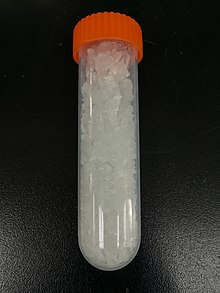Cerium nitrates
Often these compounds contain water, hydroxide, or hydronium ions in addition to cerium and nitrate.
It is a component in a burn treatment cream that also includes silver sulphadiazine.
[1][2] At 150 °C the hexahydrate loses water of crystallization to make a trihydrate, which itself decomposes above 200 °C.
[4] Hydronium cerium(III) nitrate hydrate, Ce(NO3)5(H3O)2.H2O[5] is monoclinic with space group P2/c.
[6] Cerium tetranitrate pentahydrate is prepared by evaporating a solution of ceric nitrate in concentrated nitric acid.
[7] Ceric nitrate is quite soluble in non polar solvents such as ethyl ether.
The solubility of this nitrate in non-polar solvents allows the separation of cerium from other rare earths.
It also forms upon evaporation of solutions of cerium(IV) in nitric acid.
[20] Cerous magnesium nitrate is the first discovered member of a divalent series CeM(II)(NO3)5.
Low thermal resistance is important at temperatures below 1K, because there is not much temperature difference to cause a large heat flow rate, and cooling can take an excessive time if there are barriers to heat transfer.
The crystals are clear rod shaped monoclinic with space group P2/c.
The way the components are arranged in the crystal is that there are six nitrates around each cerium atom, however to get to the average of five per cerium, two nitrate groups on each, link the atoms into a chain along the a axis.
[22] A related series with ratio 1.5 of the monovalent ion to cerium includes 2Ce(NO3)3.3(NH4)NO3.12H2O[20] A mixed caesium, sodium cerium triple nitrate Cs2NaCe(NO3)6 crystallizes in the cubic system.
[30] The alkali metals form orange-red monoclinic crystals as a double salt with ceric nitrate: M2[Ce(NO3)6] with M=K, Rb, Cs, or [NH4].


